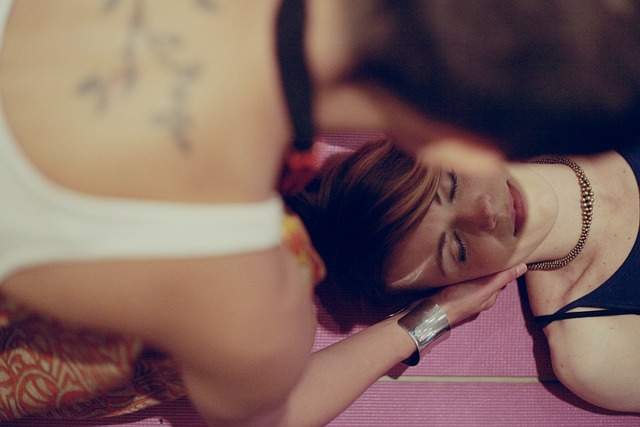Holistic posture correction combines physical exercises, mindfulness, and environmental adjustments to achieve optimal body alignment. Targeted routines strengthen key muscle groups, realigning the spine, hips, and shoulders for enhanced core strength and stability. Mindfulness and breathing techniques support natural postural alignment, while lifestyle adjustments like regular exercises, ergonomic furniture, and mindful practices like yoga prevent postural issues and promote long-term health and well-being.
Discover the transformative power of holistic approaches to restoring natural body alignment. This comprehensive guide explores effective strategies, from understanding the intricate dynamics of posture correction exercises to integrating mindfulness and breathing techniques. We delve into lifestyle changes that promote long-lasting postural balance, ensuring you achieve optimal health and well-being. By combining exercise, awareness, and sustainable habits, you’ll unlock a robust framework for achieving and maintaining proper alignment.
- Understanding Holistic Posture Correction: A Comprehensive Approach
- The Role of Exercise in Restoring Natural Body Alignment
- Integrating Mindfulness and Breathing Techniques for Optimal Posture
- Lifestyle Changes for Long-Lasting Postural Balance
Understanding Holistic Posture Correction: A Comprehensive Approach

Holistic posture correction goes beyond mere exercise routines; it’s a comprehensive approach that integrates various techniques to address the interconnectedness of the body, mind, and environment. This method recognizes that optimal alignment is not just about physical positioning but also involves emotional well-being, mental clarity, and the quality of our surroundings. By combining targeted exercises like specific stretches and strength training with mindfulness practices and environmental adjustments, individuals can achieve a more balanced and harmonious state.
Posture correction exercises are tailored to enhance flexibility, strengthen muscles, and improve joint mobility, all while fostering awareness of one’s body in space. This holistic perspective encourages individuals to become more attuned to their bodies’ needs, enabling them to make informed choices that support long-term health and well-being. It’s not just about fixing a hunchback or correcting a scoliosis curve; it’s about unlocking the body’s inherent potential for stability, comfort, and resilience.
The Role of Exercise in Restoring Natural Body Alignment

Exercise plays a pivotal role in restoring natural body alignment, addressing imbalances that can lead to poor posture and associated health issues. Posture correction exercises focus on targeting specific muscle groups to realign the skeletal structure. These exercises often involve a combination of stretching, strengthening, and mobility routines tailored to correct misalignments in the spine, hips, shoulders, and other key areas.
By engaging in regular posture correction exercises, individuals can enhance their core strength, improve spinal stability, and promote better muscle coordination. This holistic approach not only helps in achieving aesthetic improvements by correcting hunched or slouching postures but also supports overall well-being by reducing the risk of chronic pain, musculoskeletal disorders, and other health complications linked to poor alignment.
Integrating Mindfulness and Breathing Techniques for Optimal Posture

Incorporating mindfulness and breathing techniques into your routine is a powerful way to enhance postural alignment naturally. When we’re mindful, we become more aware of our bodies’ signals, allowing us to make conscious adjustments that promote correct posture. Simple breathing exercises, such as deep abdominal breathing or diaphragmatic breathing, engage the core muscles, which are crucial for supporting the spine and maintaining proper alignment.
By combining mindfulness and focused breathing during posture correction exercises, individuals can achieve a deeper state of relaxation and awareness. This integration enables better body mechanics, ensuring that every movement is aligned with natural physiological processes. As a result, it becomes easier to maintain good posture throughout the day, reducing the risk of musculoskeletal disorders and promoting overall well-being.
Lifestyle Changes for Long-Lasting Postural Balance

Maintaining good posture is not just about looking aligned—it’s a crucial aspect of overall health and well-being. To achieve long-lasting postural balance, lifestyle changes are essential. This involves incorporating regular posture correction exercises into your daily routine. Simple yet effective movements like the cat-cow stretch, pelvic tilts, and shoulder shrugs can help strengthen core muscles and improve spinal alignment.
Additionally, mindful practices such as yoga or tai chi offer a holistic approach by combining posture correction with breath control and mental focus. Making conscious efforts to maintain proper posture during daily activities—from sitting at your desk to walking—is also vital. Supporting your body with ergonomically designed furniture and taking frequent breaks to stretch can significantly contribute to preventing postural deterioration.
Holistic approaches to restoring natural body alignment, as discussed in this article, offer a comprehensive and sustainable solution to postural issues. By combining exercise, mindfulness, and lifestyle changes, individuals can achieve long-lasting results. Posture correction exercises play a pivotal role in strengthening muscles and improving flexibility, while mindfulness and breathing techniques enhance awareness and correct posture instinctively. Adopting these practices not only improves physical health but also promotes mental well-being, ensuring a balanced and aligned body for years to come.
